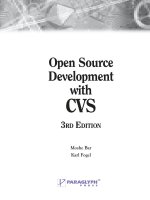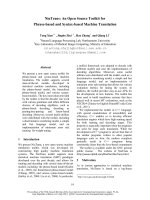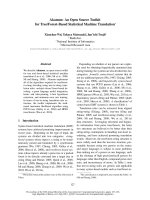network performance open source toolkit using netperf tcptrace, nist net, and ssfnet
Bạn đang xem bản rút gọn của tài liệu. Xem và tải ngay bản đầy đủ của tài liệu tại đây (4.37 MB, 431 trang )
Richard Blum
Network Performance
Open Source Toolkit
Using Netperf, tcptrace,
NIST Net, and SSFNet
01 433012 FM.qxd 6/16/03 9:06 AM Page i
Executive Publisher: Robert Ipsen
Executive Editor: Carol Long
Assistant Developmental Editor: Adaobi Obi Tulton
Editorial Manager: Kathryn Malm
Managing Editor: Pamela M. Hanley
Text Design & Composition: Wiley Composition Services
This book is printed on acid-free paper. ∞
Copyright © 2003 by Richard Blum. All rights reserved.
Published by Wiley Publishing, Inc., Indianapolis, Indiana
Published simultaneously in Canada
No part of this publication may be reproduced, stored in a retrieval system, or transmitted
in any form or by any means, electronic, mechanical, photocopying, recording, scanning, or
otherwise, except as permitted under Section 107 or 108 of the 1976 United States Copyright
Act, without either the prior written permission of the Publisher, or authorization through
payment of the appropriate per-copy fee to the Copyright Clearance Center, Inc., 222 Rose-
wood Drive, Danvers, MA 01923, (978) 750-8400, fax (978) 646-8700. Requests to the Pub-
lisher for permission should be addressed to the Legal Department, Wiley Publishing, Inc.,
10475 Crosspoint Blvd., Indianapolis, IN 46256, (317) 572-3447, fax (317) 572-4447, E-mail:
Limit of Liability/Disclaimer of Warranty: While the publisher and author have used their
best efforts in preparing this book, they make no representations or warranties with respect
to the accuracy or completeness of the contents of this book and specifically disclaim any
implied warranties of merchantability or fitness for a particular purpose. No warranty may
be created or extended by sales representatives or written sales materials. The advice and
strategies contained herein may not be suitable for your situation. You should consult with
a professional where appropriate. Neither the publisher nor author shall be liable for any
loss of profit or any other commercial damages, including but not limited to special, inci-
dental, consequential, or other damages.
For general information on our other products and services please contact our Customer
Care Department within the United States at (800) 762-2974, outside the United States at
(317) 572-3993 or fax (317) 572-4002.
Trademarks: Wiley, the Wiley Publishing logo, and related trade dress are trademarks or
registered trademarks of Wiley Publishing, Inc., in the United States and other countries,
and may not be used without written permission. All other trademarks are the property of
their respective owners. Wiley Publishing, Inc., is not associated with any product or ven-
dor mentioned in this book.
Wiley also publishes its books in a variety of electronic formats. Some content that appears
in print may not be available in electronic books.
Library of Congress Cataloging-in-Publication Data:
ISBN: 0-471-43301-2
Printed in the United States of America
10 9 8 7 6 5 4 3 2 1
01 433012 FM.qxd 6/16/03 9:06 AM Page ii
This book is dedicated to my grandmother, Margaret Gordon.
Sorry, grandma, it’s not a mystery novel—but then again,
in a way, maybe it is.
“Trust in the Lord with all your heart and lean not on your own
understanding; in all your ways acknowledge him,
and he will make your paths straight.”
Prov. 3:5-6 (NIV)
01 433012 FM.qxd 6/16/03 9:06 AM Page iii
01 433012 FM.qxd 6/16/03 9:06 AM Page iv
Acknowledgments xvii
Introduction xix
Part One Network Performance Primer 1
Chapter 1 Defining Network Performance 3
The Elements of Network Performance 4
Availability 4
Using Availability Statistics 5
Using Large Ping Packets 7
Response Time 8
Response-Time Factors 9
Determining Response Time from Ping Packets 9
Using traceroute for Redundant Paths 10
Network Utilization 11
Network Throughput 12
Bandwidth Capacity 14
Methods of Collecting Performance Data 15
Querying Network Devices 16
How Tools Query Devices 16
Values to Query 17
Watching Existing Traffic 18
Generating Test Traffic 19
Summary 20
Chapter 2 Watching Network Traffic 21
Catching All the Traffic 21
The libpcap Library 22
Downloading and Installing libpcap 22
Using libpcap 23
Contents
v
01 433012 FM.qxd 6/16/03 9:06 AM Page v
The winpcap Library 24
Downloading and Installing winpcap 24
Developing Applications with winpcap 25
Using winpcap 25
The tcpdump Program 25
Installing tcpdump 26
Linux RPM Installation 26
Downloading the Source Code 27
Using tcpdump 27
The WinDump Program 31
Downloading and Installing WinDump 31
Using WinDump 31
Filtering Packets with tcpdump and WinDump 33
The Analyzer Program 35
The Ethereal Program 37
Downloading and Installing Ethereal 38
Using Ethereal 38
Summary 40
Chapter 3 Network Device Utilization 41
The net-snmp Package 41
Downloading and Installing net-snmp 42
Using net-snmp Utilities 44
snmpget 45
snmpgetnext 46
snmpwalk 47
snmpdelta 48
Standard Network Performance MIBs 49
Data Rates 49
Error Rates 51
Using Vendor MIBs 52
The CISCO CPU MIB 53
Using the Cisco CPU MIB 55
Summary 57
Part Two Network Performance Tools 59
Chapter 4 netperf 61
What Is netperf? 61
TCP Network Performance 62
UDP Network Performance 62
Downloading and Installing netperf 63
Downloading netperf 63
Installing the netperf Package 63
Running netserver 65
Using netserver in Standalone Mode 66
Autostarting netserver 67
netperf Command-Line Options 68
vi Contents
01 433012 FM.qxd 6/16/03 9:06 AM Page vi
Measuring Bulk Network Traffic 70
TCP_STREAM 70
UDP_STREAM 71
Measuring Request/Response Times 72
TCP_RR 73
TCP_CRR 75
UDP_RR 75
Using netperf Scripts 76
Summary 77
Chapter 5 dbs 79
dbs Features 79
The Components of dbs 80
The dbs Output 80
Before Installing dbs 81
The ntp Program 81
The gnuplot Program 82
Downloading and Installing dbs 82
Running the dbsd Program 84
Configuring Command Files 86
Sender and Receiver Commands 87
The Pattern Command 88
Sample Sender and Receiver Sections 89
Test Commands 90
Performing Tests 90
Define the Test Environment 91
Create the Command File 91
Run the Test 93
Analyze the Data 94
Summary 97
Chapter 6 Iperf 99
Iperf Features 99
The Components of Iperf 100
The Iperf Program 100
The jperf Front End 100
The Iperf library 101
Iperf Tests 101
Iperf Output 102
Downloading and Installing Iperf 103
Downloading the Source Code 104
Compiling the Source Code 104
Installing iperf 104
Using Iperf 105
Starting the Iperf Server 105
Standalone Mode 105
Daemon mode 106
Contents vii
01 433012 FM.qxd 6/16/03 9:06 AM Page vii
Performing Simple Tests 106
Testing TOS Traffic 108
Testing UDP Traffic 109
Testing Multicast Traffic 111
Testing a File Transfer 112
Testing TCP Window Sizes 113
Using jperf 114
Summary 115
Chapter 7 Pathrate 117
Using Statistics to Measure Bandwidth 118
How Pathrate Works 118
Initial Phase 118
Phase I 118
Phase II 119
How Pathload Works 119
Using Pathrate 120
The Pathrate Programs 120
Downloading Pathrate 121
Compiling Pathrate 121
Starting the Pathrate Server 122
Starting the Pathrate Client 122
Pathrate Test Output 123
Quick Termination Mode 123
Full Testing Mode 124
Initial Phase Results 125
Phase I Results 125
Phase II Results 126
Using Pathload 127
Pathload 127
Downloading and Configuring Pathload 127
Starting the Pathload Server 128
Starting the Pathload Client 128
Pathload Output 129
Requested Fleet Parameters 129
Loss Rate per Stream 130
Server Fleet Parameters 130
Context Switches 131
Packet Discards 131
Relative One-Way Packet Delay Trend 131
Fleet Aggregate Trend 132
State Variable Updated 133
Final Test Results 133
Summary 134
viii Contents
01 433012 FM.qxd 6/16/03 9:06 AM Page viii
Chapter 8 Nettest 137
What Is Nettest? 137
The lblnettest Application 138
Certificates and Keys 139
The ACLFile File 139
Test Applications 139
The OpenSSL Package 140
Downloading and Installing Nettest 142
Downloading Nettest 142
Before Compiling 143
Define All Test Hosts 143
Modify the Source Code 144
Compiling and Installing Nettest 145
Creating Certificates and Keys 146
Creating a Certificate Authority 147
Creating the Client Certificate and Key 148
Creating the Server Certificate and Key 149
Creating the ACLFile File 149
Using Nettest 150
Starting a Nettest Session 151
Performing Tests 152
Summary 154
Chapter 9 NetLogger 155
What Is NetLogger? 156
NetLogger APIs 156
NetLogger Host and Network Monitoring Tools 156
NetLogger Log File 157
NetLogger Graphical Tool 158
Downloading and Installing NetLogger 158
Source Code Distribution File 158
Binary Distribution File 160
Using the APIs 160
Functions 160
Open 160
Write 162
Close 163
Libraries 164
Using nlv 165
Types of nlv graphs 165
Configuring nlv 167
The bltGraph.pro File 167
The nlv-main.cfg File 167
The nlv-keys.cfg File 169
Summary 173
Contents ix
01 433012 FM.qxd 6/16/03 9:06 AM Page ix
Chapter 10 tcptrace 175
What Is tcptrace? 175
Console Mode 176
Graphical Mode 177
Downloading and Installing tcptrace 178
Using tcptrace in Console Mode 179
Using Basic Command-Line Options 179
Standard Session Output 179
tcptrace Filters 183
Using Module Options 185
Graphical Programs 187
xplot 187
jPlot 188
Using tcptrace in Graphical Mode 189
Standard Graphs 189
Throughput Graph 189
Time Sequence Graph 191
Traffic Module Graphs 193
Summary 194
Chapter 11 ntop 197
What Is ntop? 198
Traffic Measuring 198
Data Received 198
Data Sent 199
Network Throughput 199
Traffic Monitoring 200
Statistics 200
IP Traffic 201
IP Protocols 201
Before Installing ntop 202
Creating the ntop User ID 203
Loading Support Software 203
Downloading and Installing ntop 204
Compiling and Installing gdchart 205
Compiling ntop 206
Running ntop 206
Starting ntop for the First Time 207
ntop Command-Line Parameters 208
Using ntop Command-Line Parameters 209
Monitoring Network Traffic 209
Analyzing a tcpdump Dump File 210
ntop Access Log File 211
Viewing ntop Data 211
Connecting to ntop 211
Watching Hosts 212
Watching Network Traffic 214
Summary 215
x Contents
01 433012 FM.qxd 6/16/03 9:06 AM Page x
Chapter 12 Comparing Network Performance Tools 217
Tools for Testing the Network 218
Bulk Data Transfers 218
Using Pathrate to Find the Network Bottleneck 219
Using netperf to See Actual Network Bandwidth 221
Using ntop to Analyze Network Traffic 223
Using NetLogger to Analyze Host Functions 225
Request/Response Traffic 225
Using netperf to Simulate HTTP Traffic 227
Using tcptrace to Watch HTTP Sessions 228
Analyzing Production Traffic 229
Analyzing an FTP Session 230
Using tcptrace 230
Using ntop 233
Analyzing a Telnet Session 234
Using tcptrace 235
Using ntop 237
Summary 237
Part Three Application Performance Tools 239
Chapter 13 Measuring Application Performance 241
Methods of Testing Network Applications 242
The Test Network 242
Production Network 243
Network Emulation 243
Network Traffic Generator 244
Network Emulation Device 244
Network Simulation 245
Discrete Event 246
Analytical 246
Modeling Network Problems 246
Bandwidth Constraints 247
Packet Errors 248
Lost Packets 248
Out-of-Order Packets 249
Delayed Packets 250
Modeling Network Devices 251
Hubs 251
Switches 252
Routers 253
Quality of Service 254
Weighted Fair Queuing 254
Stochastic Fair Queuing 254
Random Early Detection 255
Firewalls 255
Contents xi
01 433012 FM.qxd 6/16/03 9:06 AM Page xi
Wide Area Networks 256
Modeling Point-to-Point Networks 256
Modeling Packet-Switching Networks 257
Wireless Networks 257
Summary 258
Chapter 14 dummynet 259
What Is dummynet? 260
Dummynet Features 260
Using the dummynet Host 261
The ipfw Application 263
Creating New Rules 264
Rule Number 264
Rule Probability 265
Rule Action 265
Rule Logging 266
Rule Definition 266
Listing Rules 266
Removing Rules 267
dummynet Rules 268
dummynet Commands 268
Bandwidth 269
Delay 269
Random Packet Loss 270
Queue Size 270
Configuring WFQ 271
Configuring Multipath Links 271
Installing dummynet 271
Kernel Options 272
Building a New Kernel 273
Installing PicoBSD 273
Controlling dummynet 274
Testing dummynet 275
Setting Network Delays 275
Setting Network Bandwidths 277
Summary 277
Chapter 15 NIST Net 279
What Is NIST Net? 279
NIST Net Emulations 280
Bandwidth Limitation 280
Packet Delay 281
Packet Reordering 281
Packet Loss 281
Packet Duplication 282
Packet Diversion 282
The NIST Net Kernel Module 282
xii Contents
01 433012 FM.qxd 6/16/03 9:06 AM Page xii
The NIST Net Configuration Tools 285
The NIST Net Optional Tools 286
mungebox 287
nistspy 287
Downloading and Installing NIST Net 288
Downloading NIST Net 288
Compiling NIST Net 288
Getting the Required Files 289
Compiling the Source Code 290
Loading NIST Net 291
Using NIST Net 292
Using cnistnet 292
Using xnistnet 295
Creating Rules 296
Modifying Rules 297
Summary 298
Chapter 16 Network Traffic Generator 301
What Is Network Traffic Generator? 301
How Network Traffic Generator Works 302
The Core Modules 302
The Protocol Modules 303
The Payload Modules 303
The Response Modules 304
The Network Traffic Generator Programs 304
Command-Line Interface 304
X Windows Interface 305
Generating Network Traffic 306
Bulk Data Transfers 306
Client/Server Transactions 307
Connectionless Communication 308
Downloading and Installing the Package 308
Downloading 308
Before Compiling 309
fastdep 309
Kylix Libraries 310
Compiling and Installing 311
Using Network Traffic Generator 312
Command-Line Options 312
Server 312
Client 313
Setting Up a Test 315
Test Host Placement 316
Test Host Configuration 316
Watching the Test Traffic 317
Summary 320
Contents xiii
01 433012 FM.qxd 6/16/03 9:06 AM Page xiii
Chapter 17 ns 321
What Is ns? 321
Network Simulator Programs 322
ns 322
nam 323
xgraph 324
Network Model Elements 324
Network Nodes 324
Network Links 325
Network Agents 326
Network Applications 327
ns Modeling Language 329
Downloading and Installing ns 330
Downloading 331
Compiling and Installing 332
Validating the Installation 332
Performing a Network Simulation 332
Creating the Simulation Model 333
Running the Simulation 336
Using nam 338
Using xgraph 339
Summary 340
Chapter 18 SSFNet 343
What Is SSF? 344
Entities 344
Processes 344
Events 345
In Channels 345
Out Channels 345
What Is SSFNet? 345
Libraries 345
Domain Modeling Language (DML) 346
Networks 347
Hosts 349
Links 350
Routers 351
Protocols 352
Downloading and Installing SSFNet 353
Downloading 354
Installing 354
Creating a Development Environment 355
Using SSFNet 356
Creating a Model 356
Running the Simulation 360
Interpreting the Results 362
Summary 364
xiv Contents
01 433012 FM.qxd 6/16/03 9:06 AM Page xiv
Chapter 19 Comparing Application Performance Tools 365
Modeling the Production Environment 365
The Production Network 366
Modeling the Network 367
Using ns 368
Building the Model 368
Running the Model 371
Interpreting the Results 372
Using SSFNet 374
Building the Model 374
Running the Model 377
Interpreting the Results 379
Using dummynet 379
Building the Emulation Environment 379
Running the Emulation 380
Using NIST Net 381
Building the Emulation Environment 381
Running the Emulation 383
Final Results 383
Summary 384
Appendix Resources 387
Index 391
Contents xv
01 433012 FM.qxd 6/16/03 9:06 AM Page xv
01 433012 FM.qxd 6/16/03 9:06 AM Page xvi
First, all glory, honor, and praise go to God, who through His Son makes all
things possible, and who gives us the gift of eternal life.
I would like to thank all the great people at Wiley Publishing, Inc. for their
help, guidance, and professionalism. Thanks to Carol Long, the Acquisitions
Editor, for offering me the opportunity to write this book, and to Adaobi Obi
Tulton, the Assistant Developmental Editor, for both helping guide this book
along, and working to help make the paragraphs make sense. Also many
thanks to Carole McClendon at Waterside Productions for her help in arrang-
ing this opportunity for me.
Finally, I would like to thank my parents, Mike and Joyce Blum, for their
dedication and support, and my wife Barbara and daughters Katie Jane and
Jessica for their faith, love, and understanding, especially while I was writing
this book.
Acknowledgments
xvii
01 433012 FM.qxd 6/16/03 9:06 AM Page xvii
01 433012 FM.qxd 6/16/03 9:06 AM Page xviii
The job of the network administrator is complicated. If you are a network
administrator, not only are you responsible for installing and maintaining the
wires, hubs, switches, and possibly routers and firewalls, but you must also
ensure that they all work efficiently together. Of course, this all must be done
within the constraints of a budget, which these days is often smaller than what
you really need to accomplish the job. The goal of this book is to show you
some freely available tools that can be used to help monitor and troubleshoot
a network, providing you with a toolkit of programs to use when problems
arise.
The network administrator is often the first line of defense whenever any-
thing behaves oddly on the network. Even when there is no clear-cut culprit,
the network administrator has to prove that the network is not at fault. Net-
work performance is often a difficult thing to measure. What is fast perfor-
mance for one application can often be slow for another. It is your job to ensure
that the network and the network applications are performing properly for
your environment. This book is intended to help you with this task.
Overview
Network performance has been studied for many years, which has produced
lots of theoretical work on how network traffic is affected by network load.
Unfortunately, for the average network administrator in charge of the com-
pany network, equations and theories do not help solve real-world problems,
such as slow network application performance. Instead, what is required is
Introduction
xix
01 433012 FM.qxd 6/16/03 9:06 AM Page xix
real-world tools that can monitor and analyze network behavior, to identify
the cause of network performance problems and determine how to quickly
(and usually, cheaply) fix them.
With the explosion of Open Source software in recent years, many free
applications are becoming available that can help the average network admin-
istrator. Usually these applications can be easily downloaded, configured, and
used to help determine both network performance and network application
performance. Money that companies used to have to spend on network per-
formance tools can now be used to purchase equipment to actually solve net-
work problems.
Most Open Source applications are written for the Unix platform. In the
past, this was a huge restriction, especially for network administrators who
didn’t happen to have a big Unix box lying around. However, with the popu-
larity of free Unix distributions such as Linux and FreeBSD, anyone can have
a Unix platform for Open Source applications. Now, for little or no money,
network administrators can have a fully functional network monitoring and
analysis toolkit at their fingertips. This provides opportunities for network
troubleshooting that previously were only available with expensive high-end
systems.
How This Book Is Organized
This book is divided into three sections. The first section presents a network
performance primer, showing some of the basic elements that affect network
performance, and explaining how to use some simple Open Source tools to
monitor them.
Chapter 1, “Defining Network Performance,” describes the techniques used
by the Open Source tools to monitor network performance. Understanding
how the tools work makes it easier to understand the output, and to determine
what solutions can be used to solve any problems detected.
Chapter 2, “Watching Network Traffic,” presents some Open Source tools
used for monitoring network traffic, in both the Unix and Windows environ-
ments. Monitoring network traffic is often an excellent troubleshooting tool
when looking for network performance problems.
Chapter 3, “Network Device Utilization,” discusses how to use the Simple
Network Management Protocol (SNMP) to query existing network devices for
performance data. The Open Source tool net-snmp can be used to monitor real-
time network performance data straight from the network devices themselves.
The second section of the book presents tools used for monitoring network
performance. Determining network performance is done by sending a known
stream of data between two endpoints located on the network. By measuring
the delays in the data stream, the performance tool can determine what net-
work problems may be present.
xx Introduction
01 433012 FM.qxd 6/16/03 9:06 AM Page xx
Chapter 4, “netperf,” describes the netperf network performance tool,
developed by Hewlett-Packard. The netperf application can be used to send
different types of data streams across a network, and monitor the performance
of each type of data stream.
Chapter 5, “dbs,” discusses the dbs performance tool, developed at the Nara
Institute of Science and Technology, in Japan. The dbs application can be used
to perform network tests between two remote hosts on the network, without
being connected to either one.
Chapter 6, “Iperf,” presents the Iperf application, which was developed at
the National Laboratory for Applied Network Research (NLANR), and is cur-
rently maintained at the University of Illinois. The Iperf application focuses on
how TCP parameters can affect network application performance, and how
fine-tuning TCP host parameters can increase the performance of many net-
work applications.
Chapter 7, “Pathrate,” discusses both the Pathrate and Pathload applica-
tions, developed and maintained by Constantinos Dovrolis, who is currently
working at Georgia Tech. Both applications rely on advanced network statisti-
cal calculations, involving the delays present in transferring packets across
network devices along the path between the two endpoints.
Chapter 8, “Nettest,” describes the Nettest application, developed at the
Lawrence Berkeley Labs as a secure shell for performing network tests
between hosts. The Nettest application uses the OpenSSL security application
to encrypt network performance sessions, and to control who is allowed to run
network tests.
Chapter 9, “NetLogger,” presents a slightly different technique used for
monitoring network application performance. The NetLogger application pro-
vides a set of APIs that is used within network applications for logging net-
work events, such as writing data to the network and reading data from the
network. Once the network log is created, a graphical interface allows you to
monitor each of the network events and determine which events have poor
performance.
Chapter 10, “tcptrace,” discusses the tcptrace application, developed at
Ohio University. The tcptrace application analyzes data captured by the tcp-
dump application, quickly displaying information about each TCP session in
the trace.
Chapter 11, “ntop,” introduces you to the ntop application, developed at the
University of Pisa, in Italy, to produce graphical Web pages showing network
utilization by each device on the network. This helps you determine which
devices are consuming the most resources on the network.
Chapter 12, “Comparing Network Performance Tools,” wraps up the net-
work performance tool section by presenting a sample network environment,
and showing how each tool can be used to monitor network performance on
the sample network.
Introduction xxi
01 433012 FM.qxd 6/16/03 9:06 AM Page xxi
The third section of the book describes how to use network application per-
formance tools to analyze how network applications behave in different net-
work environments. By analyzing the applications in a test network, you can
often see potential problems before the application is released in the produc-
tion network.
Chapter 13, “Measuring Application Performance,” discusses how network
application performance testing tools—both network emulators and network
simulators—can help you determine how applications will perform in the pro-
duction network.
Chapter 14, “dummynet,” describes the dummynet application, which is
available on FreeBSD systems to emulate network behavior using a FreeBSD
host. This enables a single FreeBSD host to be used within a test network to
emulate the network delay, bandwidth limitations, and packet loss of a full
production network.
Chapter 15, “NIST Net,” discusses the NIST Net application, developed at
the U.S. National Institute of Standards and Technology to simulate network
behavior using a Linux system. This application provides the network emula-
tion functions to use a Linux system to model the production network.
Chapter 16, “Network Traffic Generator,” presents the traffic application,
which is used to generate specific data traffic patterns on the network. This can
be used to artificially emulate production network traffic on a test network
using a single host.
Chapter 17, “ns,” describes the Network Simulator application, developed
at the University of California Berkeley as a method to simulate network
behavior without having to actually have a test network available.
Chapter 18, “SSFNet,” discusses the Scaleable Simulation Framework (SSF),
and how it is used to model network behavior, using either C++ or Java.
Chapter 19, “Comparing Application Performance Tools,” wraps up the
final section by showing how to model production networks, and how to use
the emulation and simulation tools presented to predict network application
performance.
Who Should Read This Book
The primary focus of this book is to help network administrators and techni-
cians monitor and analyze network performance. Often it is not easy to deter-
mine what causes network performance problems. The tools presented in the
first two sections of the book can be used in the production network to help
identify the cause of network performance issues. The text explains how to
install and configure each tool, and describes how to use the tool in the pro-
duction network.
xxii Introduction
01 433012 FM.qxd 6/16/03 9:06 AM Page xxii
Because network applications go hand in hand with networks, the sec-
ondary focus of the book is to help in the analysis of network application per-
formance. Both network application developers and network administrators
must test network applications within a test network before deploying them to
the production network. For this to be done properly, the production network
environment must be accurately duplicated within the test network. Open
Source network emulators and simulators make this possible. The book pre-
sents each emulator and simulator tool, showing how it can be used to dupli-
cate the production network environment.
Tools That Are Needed
This book uses mainly Open Source tools intended for the Unix platforms.
Some type of Unix platform is required to install, compile, and operate each of
the tools. The use of Open Source Unix distributions, such as FreeBSD or
Linux, is highly encouraged. All of the tools presented were installed, com-
piled, and tested on a Mandrake Linux 8.0 system (with the exception of
dummynet, which requires a FreeBSD system).
All of the tools are available for download from their respective Internet
Web sites. Some type of Internet access is required to access the tools’ distribu-
tion packages. Of course, the faster the Internet connection, the quicker the
downloads will proceed. Some of the distribution packages are fairly large, so
using a slow-speed modem connection may take a while.
Summary
Trying to troubleshoot network performance issues while customers are com-
plaining is not a fun job. Hopefully this book will present some ideas and
options to help you identify and fix network problems before your customers
notice them. Nothing takes the place of experience. Monitoring and analyzing
network performance when there are no problems often helps in times when
there are problems. Knowing what a healthy network looks like helps in iden-
tifying problems in a sick network.
In today’s environment, there are constant advances in network technology.
One advantage of using Open Source network performance tools is that they
are often updated or replaced to accommodate newer features. You should
always monitor the Internet and network performance newsgroups for new
tools, and advances in the old tools. This will ensure that you will maintain an
efficient and effective network performance toolkit.
Introduction xxiii
01 433012 FM.qxd 6/16/03 9:06 AM Page xxiii









